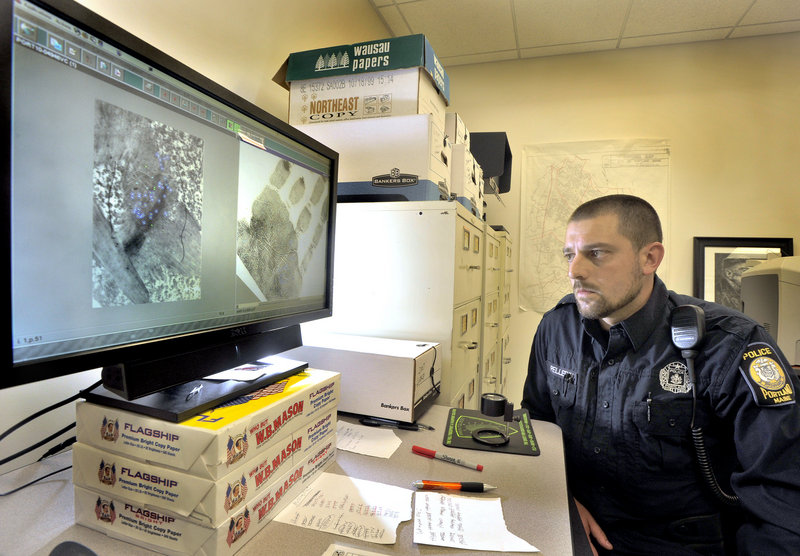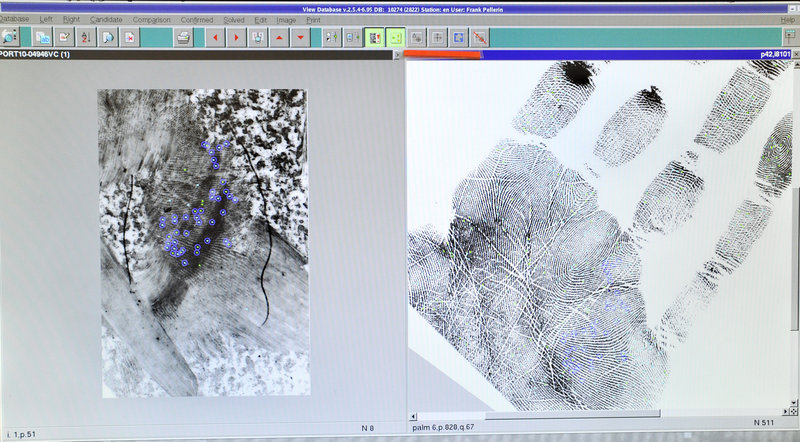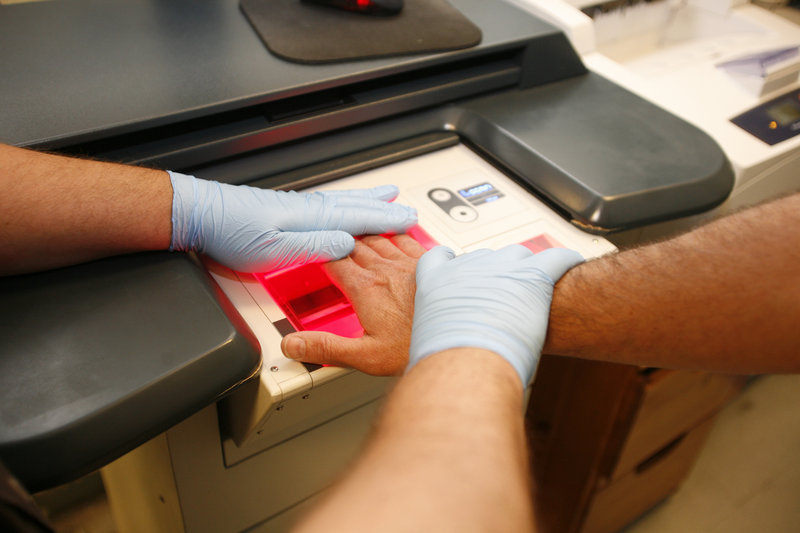Last month, a Portland woman reported that a stranger broke into her High Street apartment and tried to rape her.
She didn’t know him, and police had only a vague description to work with, but within a few hours officers identified the suspect, and tracked him to a West End apartment just two days after the attack.
Evidence technicians had retrieved a fingerprint from a foil condom wrapper, downloaded it into the regional crime lab’s automated fingerprint identification system and matched it with Mohammed Mukhtar, an 18-year-old who had been arrested — and fingerprinted — for allegedly driving without a license a month earlier.
While the cutting-edge science of DNA analysis gets a lot of the glory in forensics, fingerprints — and increasingly, palm prints — remain a workhorse of crime scene investigation.
The palm is in many ways like a giant fingerprint, containing the same complex and unique combination of whorls and loops. Even when there are no usable fingerprints, evidence technicians can sometimes lift enough of a palm print to get a match.
Greater Portland’s Metropolitan Regional Crime Laboratory has in the past two and a half years linked fingerprints taken from 295 crime scenes — called latent prints — to prints collected by corrections officers at the Cumberland County Jail, identifying suspects and closing cases.
In the 18 months since the jail began taking palm prints as part of its routine intake process, palm prints collected at crime scenes have been matched to offenders 65 times.
The automated fingerprint/palm print identification system consists of an extremely powerful desktop computer and a flatbed — albeit state of the art — scanner, which cost $45,000 and $30,000, respectively.
“I think that by far it’s assisted us in solving more crimes than any other piece of equipment we’ve been able to purchase,” said Assistant Chief Vern Malloch of the Portland Police Department, where the regional crime lab is housed.
The lab’s success rate is so high that the manufacturer, SPEX Forensics, is using it to market its products.
The key to the lab’s success has been its ability to electronically scan and compare prints quickly.
When a person is booked into the county jail, corrections officers scan prints electronically, and those digital images are automatically compared with all latent prints in the database.
“It’s only a couple minutes, but you take a busy night with 15 or 16 people coming in and half of them intoxicated, it can be difficult. But the payback has been pretty good,” said Cumberland County Sheriff Kevin Joyce, who oversees the jail and whose law enforcement division participates in the regional lab.
The jail has long served as a repository of information about offenders, including vital statistics, identifying marks and mug shots. It makes sense to collect electronic fingerprint information from all offenders the jail processes, even if their infractions are minor, Joyce said.
“If you spend extra time today fingerprinting somebody coming in for a driving offense … they may be a burglary suspect on down the road,” Joyce said.
The lab has archived 20,450 sets of fingerprints — although some are multiple sets from the same offender because they’re taken each time a person is booked at the jail. It has archived 10,500 palm prints.
Of these, 1,227 fingerprints and 135 palm prints collected from crime scenes are from unknown persons.
When prints are collected from a crime scene, they are scanned into the system and immediately compared to all known offenders and existing crime scene prints in the system.
The “hit rate” for the number of latent prints that match with a known offender’s prints exceeds 20 percent.
When the computer suggests a possible match, a person trained in print comparison will check to see whether in fact there is a “hit.”
Bangor uses the same system as Greater Portland, but is still loading prints from previous crimes into its database. It’s a time-consuming process because someone has to go into each case file and determine whether any prints were gathered.
Neither Bangor nor Greater Portland can search the state’s database electronically, because the proprietary software each uses doesn’t communicate. To do a statewide search, investigators from each county must submit a copy of prints collected from a crime scene for the state to analyze against its database.
Bangor and Portland eventually will be able to search each other’s databases, however, because they both use the same system, said Bangor Detective Larry Morrill.
Malloch said directors of the regional lab understood when purchasing its system that it wouldn’t be able to communicate with the state. But the system was more affordable and better met the needs of departments participating in the regional lab.
Also, most crimes — some estimates suggest about 90 percent — are committed by local offenders, Malloch said. Police can still send prints to the state, which can compare them to the northern New England database.
The automated print systems won’t solve every crime. Usable prints are only recovered from about 30 percent of crime scenes, Malloch said.
In the past, palm prints were only collected for so-called major crimes. But the scanners make it easy to collect them.
Now, every county jail in the state scans fingerprints and palm prints, said Kim Stevens, senior lab scientist at the State Crime Lab. They are sent to the state for inclusion in the State Bureau of Identification database. The state shares with federal authorities.
Maine State Police Lt. William Harwood said that even though the Greater Portland lab can’t automatically check the state’s database, it can email in the images to the State Crime Lab.
The check is not immediate, but the backlog of roughly 40 cases is much smaller than the 300 it was just a few years ago, he said.
Staff Writer David Hench can be contacted at 791-6327 or at: dhench@pressherald.com
Send questions/comments to the editors.





Success. Please wait for the page to reload. If the page does not reload within 5 seconds, please refresh the page.
Enter your email and password to access comments.
Hi, to comment on stories you must . This profile is in addition to your subscription and website login.
Already have a commenting profile? .
Invalid username/password.
Please check your email to confirm and complete your registration.
Only subscribers are eligible to post comments. Please subscribe or login first for digital access. Here’s why.
Use the form below to reset your password. When you've submitted your account email, we will send an email with a reset code.